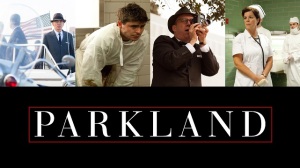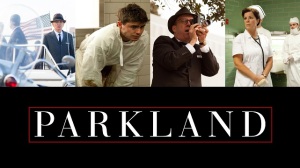Last night I attended the UK premiere of Parkland at the London Film Festival. Written and directed by Peter Landesman and based on the writing of Vincent Bugliosi (in his 2007 book Reclaiming History: The Assassination of President John F Kennedy and, in particular, the chapters of that book that became the later release Four Days In November), the film tells the story of one of the most momentous days in history – 22nd November 1963 and the assassination from the perspectives of ordinary individuals who found themselves caught up in unimaginable events.
The film takes its title from Parkland Memorial Hospital, the hospital to which both the President and Lee Harvey Oswald were taken and pronounced dead within hours of each other. Its style chooses to shine a light on a number of different character strands that are interwoven throughout the film and one key strand is indeed that which takes place at the hospital, where the same doctors and nurses attempted to save both men. Other strands focus on Abraham Zapruder, whose 8mm camera film would become one of the most scrutinised pieces of footage ever captured, as the only film to record the murder from beginning to end, the head of the Dallas secret service Forrest Sorrels, the FBI agent James Hosty, the secret service team and the family of Lee Harvey Oswald, in particular his older brother Robert.
Novelist and first time director Peter Landesman’s style for the film reflects his past as a journalist, as the film has a documentary style, with unsteady camera movements and the intercutting of actual footage from 1963, which gives the audience the perspective of someone present in the moment. The director indeed said in the Q&A after the screening that that was one of his reasons for working with cinematographer Barry Ackroyd (who also worked on Captain Phillips), in order to give the film a feel of almost being in a war zone environment. It was also important to him and the producing team (Tom Hanks & Gary Goetzman) that the film was made only if it was factual – that everything included could be verified and confirmed. Therefore this is not a film that delves in any way in to the many conspiracy debates that still surround the assassination or adds artistic licence in the way Oliver Stone did with his film JFK. Instead it focuses on the smaller real life moments that are often overlooked when discussing these tragic events, for example, the lead nurse in the ER making sure Lee Harvey Oswald does not live or die in the same room that the President had been in just hours before or the practicalities of how to get the coffin on to Air Force One so that the President was not stored as if a piece of luggage.
I did find the film to be quite powerful, possibly due to the fact that it isn’t a glorified Hollywood movie and instead feels far more realistic, and it does contain some very moving moments. Paul Giamatti is (as usual) superb in the film, portraying a man whose name I knew but knew nothing more about. His portrayal of Abraham Zapruder is of a man who is utterly devastated by what he has witnessed and indeed is horrified that he has captured such a terrible event on camera. The shock he displays in the aftermath, as the secret service agents take him to have the film developed is very believable. I particularly liked the moment when the film is played and his grandchildren appear on screen in home movie footage. His apology to the impatient secret service for the delay is met with the touching response that it’s okay as this is his life and it looks like a nice one. You understand in that moment that Zapruder’s life has been altered in a way he will never be able to forget. You also understand that he is a man who is desperate to do the right thing but isn’t entirely sure what that is and his conflicted emotions as to what to do with the footage as the media offers flood in is well acted. The director explained at the screening that on the first day of the shoot they filmed Paul as Zapruder in Dealey Plaza in the actual location and that it was a very emotional experience for them all. Indeed the take in the film is apparently the first take as he let Paul do whatever came naturally in that emotional moment.
The other key individual for me was Robert Oswald, brilliantly portrayed by James Badge Dale. We see the character go through the shock of hearing of his brother’s arrest, to anger at trying to understand why he has done it, to frustration at his mother’s astonishing behaviour and reaction to events. This is certainly a person I knew nothing about and his performance felt very real and believable and I felt incredibly sorry for him and indeed the burial scene of Lee Harvey Oswald is very moving due to the focus on Robert. His desperate plea to watching press to help carry the coffin from the hearse to the grave in the absence of anyone else to help was very effective.
There are also some good performances from the President’s security team, who struggle to comprehend what has happened and what to do next. I particularly liked the moment when Tom Melling (of Smallville fame) refuses to allow anyone else to drive the hearse from the hospital to the waiting plane, his loyalty and attachment to the President clear. The scene that follows in which the secret service manhandles the coffin up the plane steps and through the door was quite an unpleasant and undignified moment. However it seems very realistic in its simplicity and felt true to the style of the film in highlighting moments that haven’t been given much thought before.
The hospital scenes are obviously very powerful due to the nature of the subject matte and there are strong performances from Zac Efron, Colin Hanks and Marcia Gay Harden as the doctors and lead nurse trying in vain to save the President when really they know it is too late. I would have liked to have seen more of the emotional impact on them outside the small emergency room in which most of their scenes occur. Billy Bob Thornton is also good as the head of the Dallas secret service.
This brings me to my main issue with the film. The performances of the ensemble cast are very good, there are some powerful moments and I liked the directorial style. However at 93 minutes long there isn’t sufficient time to give enough depth to a number of the characters included in the story. Ron Livingston for example plays James Hosty, the FBI agent who has been tracking Lee Harvey Oswald for 18 months prior to the killing and whose boss is full of anger that they did not predict what he was going to do and stop it. The FBI is very much side-lined in the film and it would have been nice to see more from Ron and this story strand, which felt very much unfinished. I agree somewhat with some views that this may have been better as a miniseries, able to delve in to the character strands far more deeply (which was indeed the initial plan by Hanks).
However, overall I thought this was an interesting film, which is effective in looking at such well known events from perspectives that may otherwise never have been considered more widely, albeit not with as much depth as I would have liked. It will certainly be a film that causes people to think about the tragedy in a new light.
Parkland opens in UK cinemas on 22 November 2013 (moved back from 8 November) to coincide with the 50th anniversary of the assassination. It has already been released in America.
A link to the official trailer for the film is below:


